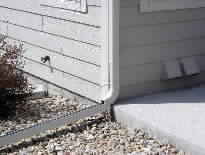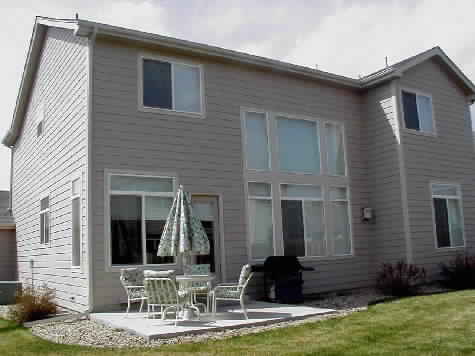|
|
|
 |
 |
 |
| 41 Countries in 5 Hours with |
| 100 Watts into a Rain Gutter! |
| by Jack Ciaccia, WM�G |
| |
| I decided I would give the ARRL International CW DX Contest a try |
| from my new, super stealthy HF radio setup... let me explain. |
| My HF rig is an ICOM 745 and a Dentron transmatch running 100w but my antenna system is a little unusual though. After I moved to my |
| new QTH in Lafayette, CO, I tried to put up my trusty old Butternut |
| HF6VX Vertical. I am located in a covenant controlled neighborhood |
| and thought the vertical would suffice as it is ground mounted and is |
| not taller than my house. But, the local neighborhood HOA |
| "watchdog" showed up at my front door about one week after I put it |
| up and reminded me about the HOA rules of NO OUTSIDE ANTENNAS! |
| It turns out, she lives in the house directly in back of me and can see |
| the antenna from her dining room window -- my typical luck! Well, |
| not to put the nice radial system I had recently "planted" to waste, I |
| started to think about some alternative, stealthy antenna designs. |
| I noticed the rain gutters and downspouts of my house. They were |
| aluminum and brand new so they probably made contact |
| continuously. The downspout section is about 25 feet high and it |
| connects to a horizontal gutter run which is 35 feet long. Hmmm... 60 |
| feet of conductive material in an inverted 'L' Marconi type design and |
| ready made! I'd heard of Hams loading up their rain gutters before |
| but never thought that I would he relegated to this option myself. I ran a 50 foot piece of RG-8X out from the "shack" to the bottom of the drainspout. I drilled a hole in the drain pipe and attached a sheet |
| metal screw. To this screw I attached the center conductor of the |
| RG-8X coax. The shield side of the coax was then soldered to the |
| ground radial leads. The ground radial system consists of 10 random |
| lengths of 4 conductor antenna rotor cable buried in the lawn and the |
| ends of three of these radials are also screwed into my basement's |
| metal window wells too. |
| I tested the stealth antenna with my MFJ antenna analyzer to see if |
| there were any inherent resonant points on this system. There were a |
| few spots where the "Rain Gutter Antenna" was under 2:1 SWR. |
| Coincidentally, these occurred at the top of the 75 meter band and |
| again in the middle of the 15 meter band... "Life is good". Time to |
| attach it to the transmatch and HF rig and "fire it up". It loaded up |
| nicely on 75 meters so I thought I would try to check into one of my |
| favorite WAS nets, the GERATOL Net on 3.768 MHz. Net control was in Indiana and had no problem hearing me. As the net went on, Yardley Beers, W�JF, a local, also checked in and now I had a reference station for reported signal strengths. The signal reports Yardley was getting from the same stations we worked were very similar to mine, although once in a while he would be an S unit above me. Not too bad, considering he was using a well designed trap vertical for 75 meters. |
| So now I had some confidence in my antenna system and decided to |
| try the DX contest. This would he a difficult test due to the pile ups on the DX stations. Fortunately though, the contest DX stations have |
| some excellent antennas and operators. I worked all bands 80M to |
| 10M. As I said in the title, I worked 41 different countries in 5 hours of |
| operating time on all bands. I was selective in who I called too. I |
| worked 78 total "band countries" and made 97 contacts. Most of these stations answered on my first call. I also made sure to "zero beat" right on top of their frequency before I called. |
| I spent about half of my 5 hours on 40M and worked 28 different |
| countries there in the evening. In one hour on 20M I worked 20 more |
| countries; one hour on I5M yielded 14; 15 minutes on 10M another 9 |
| countries; and about 15 minutes on 75M with 7 more. Of course, I had |
| duplicated some of the same countries on these different bands, but |
| the total different countries worked was 41. 12 of these countries were in Central America and the Caribbean, 6 in South America, 14 in |
| Central and Eastern Europe, 3 in the South Pacific, 2 in Asia, 1 in |
| Africa, 1 in Antarctica, plus Alaska and Hawaii. |
| No doubt, the "wile and guile" I've learned over my many years of |
| DXing played a small part on my getting through, but the "Rain Gutter |
| Antenna", I thought, played pretty well too. If I had known this |
| antenna was going to perform so well, I would have planned to work |
| the entire contest and attempt to achieve a DXCC country count! |
| I've written this article in hopes of inspiring other Hams living under |
| similar conditions to look around at the possibilities of not-so-typical |
| antenna designs and give HF and DXing a try. There are many ways |
| of devising a stealthy antenna and many books have been written on |
| the subject. The satisfaction of making a QSO under not-so-ideal |
| conditions is a lot more gratifying than working DX with a KW and a |
| multi-element array at 150+ feet. Ask anyone who works QRP! Plus, |
| working under adverse conditions hones up your operating skills and |
| then, when you do have a better antenna farm, you will probably be |
| a better operator as well. |
 |



